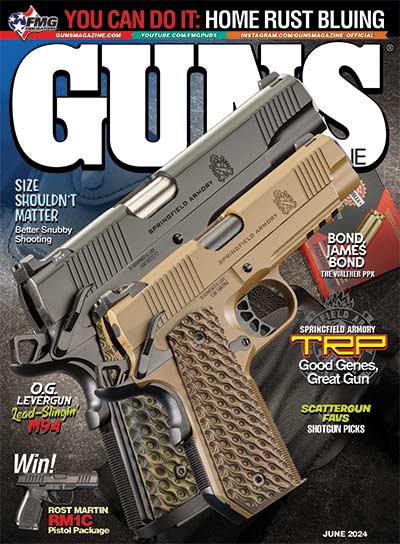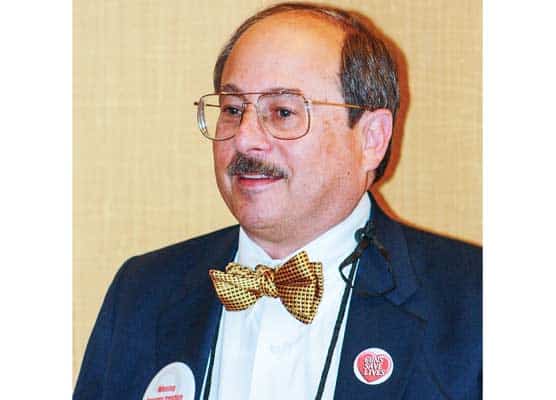The Fabulous .45-70
Golden Classic Enjoying A Rebirth

The first rifles created for the newly introduced .45 Gov’t (.45-70) was the Model 1873, with carbine version (top) and infantry rifle (bottom). The original .45 Gov’t loading contained 405-grain bullets (inset) in copper cases such as shown in the middle. Flanking it at left is a .50-70 load; at right is a .30-40 Krag.
The year 2024 is the 150th anniversary since the advent of the .45-70 — and if there was ever a cartridge or rifle to fire it that deserved to last a century and a half, this is it!
The U.S. Government introduced its brand new “.45 Government” cartridge in 1873 with a loading using 70 grains of black powder under a 405-grain lead round nose bullet. Soon the general moniker became .45-70, which has stuck unto this day. It should be noted, however, the U.S. Army had two other basic loadings: 55 grains of powder with the same 405-grain bullet intended for the 7-lb. carbines of cavalrymen. Then, in the early 1880s, another 70-grain loading was introduced with a 500-grain bullet.
GI Issue
The introductory firearms for the army’s new round were both a rifle and a carbine. Rifles had a 32-5/8″ barrel length and 22″ for carbines. Although the government named these new firearms the Model 1873, the world generally knows them now as the “trapdoor” due to the unique upward-swinging breechblock. Some modern shooters disparage trapdoors as “trashdoors” but the truth is they were well-made firearms for their era. The U.S. Army kept their trapdoors until well into the 1890s with some units fighting with them in the Spanish-American War of 1898.
As with all cartridges adopted by the U.S. Army, the .45 Gov’t soon became the darling of civilian rifle manufacturers. Winchester, Sharps, Remington, Ballard, Marlin and other companies soon offered .45 Government-chambered rifles although they sometimes created their own names for the round. For instance, the Sharps Rifle Company listed it as .45-2-1/10″, using its case length to sort it from their other .45 caliber rounds.
Those original .45-70 rifles died out in the early 20th century but were resurrected beginning about 1970. I joined the .45-70 revival in 1972. Fresh out of college and getting decent paychecks for the first time, I splurged by buying a Harrington & Richardson trapdoor carbine patterned after the government’s Model of 1873. Also purchased the same day was a Marlin Model 1895. Ruger also got involved in the .45-70 rush with their single-shot No. 1 and No. 3 being offered.
Soon Lyman’s reloading manuals started having three sections for .45-70 reloading. One was for weak actions, i.e. the 1800s single shots and their new replicas, another for Marlin’s new 1895 and Winchester’s original Model 1886 lever gun, and then a third for Ruger’s .45-70 single shots.
Even at the age of 23, I was smart enough to stick to light loads for my H&R Carbine but got a bit reckless with the Marlin. I didn’t hurt it but managed to draw blood from myself with heavy loads — the first and only time I’ve bled from shooting a rifle.
An original Model 1873 trapdoor carbine came my way in 1975 and I still have it. In fact, in 2016 a California film crew asked me to demonstrate it on location near the Little Bighorn Battlefield here in Montana. I proved to them the old carbine could still hit man-sized targets at over 300 yards with black powder ammunition. Unfortunately, not one second of my day-long shooting made the final cut of their documentary!
My enthusiasm for the .45-70 went into a hiatus for a few years while I learned about modern hunting and varmint rifles after becoming a Montana resident. Then, it reignited big-time upon discovering a new company named Shiloh was recreating the Model 1874 single-shot Sharps rifle. Although I gave much time to their other chamberings, in the long run .45-70 won out again. Of the more than 36 .45-70 rifles I’ve owned since 1972, 20 of them were the Shiloh Model 1874. My all-time favorite is the one I won for being high-Shiloh shooter at the 2006 NRA BPCR Silhouette National Championships.
Factory Loads
When I started shooting .45-70s in 1972, the only factory ammunition available was by Winchester and Remington. Their loads were identical, with 405-grain jacketed soft point bullets moving at about 1,300 fps muzzle velocity. Upon buying my two .45-70s that year, I also bought five boxes of Remington factory loads essentially for the brass.
Thereafter, very few factory loads have been fired through my .45-70s with the exception of when writing articles. With the .45-70 revival and the advent of strong rifles, both companies mentioned above started offering 300-grain bullet loads moving out at about 1,800 fps. Federal got into the game with such a 300-grain loading. Black Hills Ammunition saw a market in the other direction and came out with a 405-grain lead bullet load at approximately 1,250 fps.
Along with more powerful factory loads, bullet manufacturers also introduced more modern .45-70 bullets in weights of 300, 350 and 400 grains. Of course the .45 caliber 500-grain bullets already on the market for .458 Winchester could be safely fired in modern .45-70s but no one should expect them to expand at the 1,200-1300 fps they would be traveling with safe powder charges. Until becoming a “gun ’riter, I had never fired a jacketed bullet in any .45-70, preferring to pour my own.
My idea was since the round started with lead alloy bullets (the U.S. Government arsenal loaded the .45-70 using swaged bullets of 1:11 tin/lead alloy), Lyman still offered several .45-70 bullet molds at the time. I picked No. 457124, a round nose rated as 385 grains when using a rather hard formula of No. 2 alloy. My bullets of wheel weight alloy dropped from 390 to 400 grains. Back in those days, Lyman listed factory duplication loads in their manuals and mine dating from 1966 said 38.5 grains of IMR3031 with 405-grain jacketed soft points. The same load stuck when I transferred to the original Model 1873 carbine.
Watershed Moment
Then in 1985 something momentous happened, at least in my life. They held an experimental shooting event at the Whittington Center near Raton, NM. It involved shooting at metallic silhouettes at 200, 300, 385 and 500 meters. The kicker was only exposed-hammer, single-shot rifles made prior to 1896 or their modern replicas could be used and only rounds loaded with black powder (or Pyrodex) and lead-alloy bullets were legal. Even gas check bullets were banned.
The silhouettes were same as used in high power silhouette competition and those modern shooters could use scopes. Only iron sights were allowed in this new game! (A scoped division was added early in the 21st century because many avid shooters were aging.) I took to NRA Black Powder Cartridge Rifle (BPCR) Silhouette like a duck to water.
To make a long story short, I have now fired in hundreds of BPCR Silhouette events ranging all over the western half of this country. Until the national championships were cancelled in 2020 due to COVID 19, I had fired in all since the first official one in 1987. Although I experimented with the .40-65 and .45-90, the great bulk of my BPCR shooting was with the .45-70 and most certainly my highest scores were with rifles so chambered.
I have loaded and fired tens of thousands of black powder-charged .45-70 rounds, ending up favoring a load of 64 grains of Swiss 1-½ Fg black powder under 560-grain bullets from a custom Steve Brooks mold. After considerable experimentation involving tons of lead alloy and hundreds of pounds of black powder, I have my favorite — the Shiloh Sharps Model 1874 .45-70 giving 5- and 10-shot groups of at least 1-½ minutes of angle at 200 and 300 yards. Other competitors say they can beat that and I don’t doubt them because they also can beat me at BPCR silhouette events.
So to end this I say, “Many thanks to you U.S. Army ordnance officers who worked so diligently in the early 1870s to develop such a fine cartridge for us today.”





